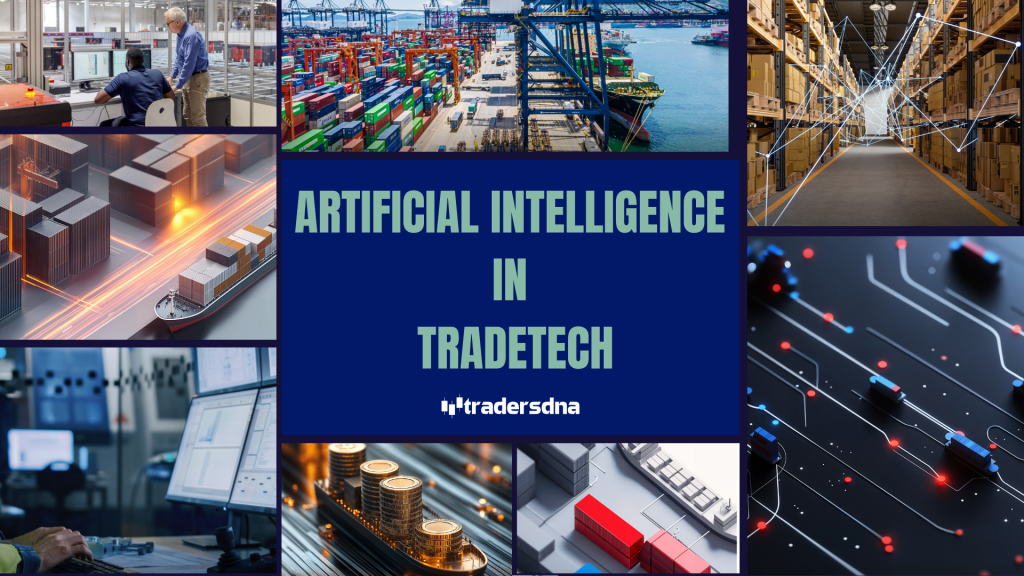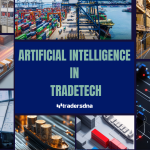According to the World Economic Forum report, AI-driven trade solutions could boost efficiency by over $1 trillion by 2030. With the right global collaboration, AI has the potential to transform who participates in trade and how it is conducted.
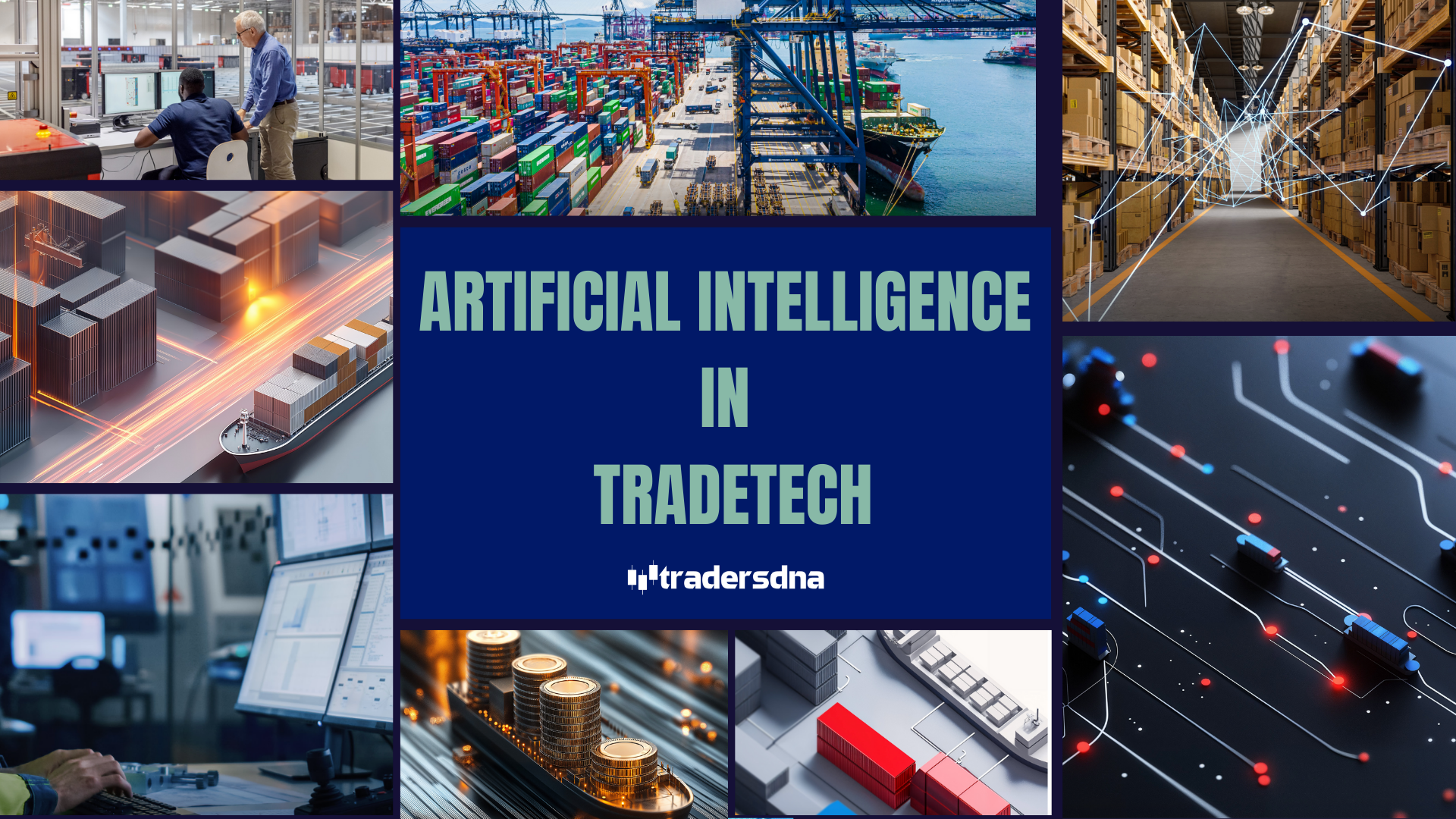
Artificial intelligence (AI) is no longer something we talk about in the distant future; it’s here, and it’s already changing the way the world trades. From making supply chains run more smoothly to cutting red tape at customs, AI is helping businesses work faster, greener, and more fairly. It’s not just a tech upgrade; it’s reshaping how goods and services move across borders and who gets to take part in the global marketplace.
The World Economic Forum’s Artificial Intelligence for Efficiency, Sustainability and Inclusivity in TradeTech report examines how AI is transforming trade in practice. According to their report, AI-driven trade solutions could boost global trade efficiency by over $1 trillion by 2030.
Building on the previous year’s TradeTech insights, this edition focuses specifically on AI’s role in supply chains, trade finance, logistics, and customs and compliance.
The report highlights that AI’s benefits can be maximised only through collaboration across borders, the creation of interoperable systems, and the alignment of global regulations. Without this, gains could be uneven, creating “trade islands” where only certain hubs reap the rewards.
AI’s Economic Potential and Impact on Trade
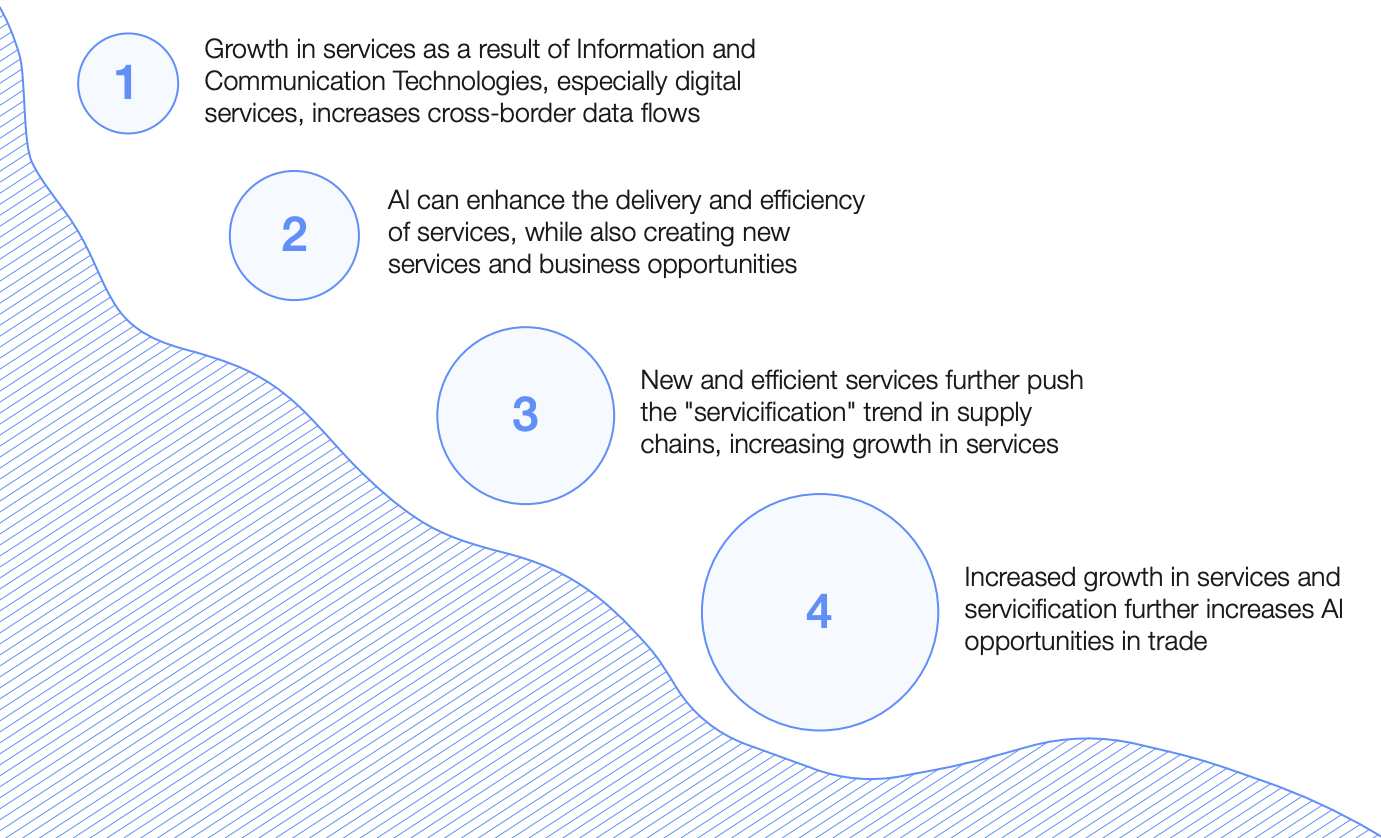
AI could add $19.9 trillion to the global economy by 2030, representing 3.5% of global GDP. In trade, its potential lies not just in boosting efficiency but also in making global commerce more inclusive and environmentally sustainable.
Two possible futures emerge:
- AI Convergence – Uniform adoption across economies, resulting in a 13.6 percentage point increase in cumulative real trade growth in goods and services by 2040.
- AI Divergence – Fragmented adoption, producing only a 9.3 percentage point increase, with benefits concentrated in AI-powered hubs.
The difference between the two scenarios is significant, around 38% higher growth under convergence, underscoring the importance of coordinated action.
Current Trends in AI Adoption for Trade
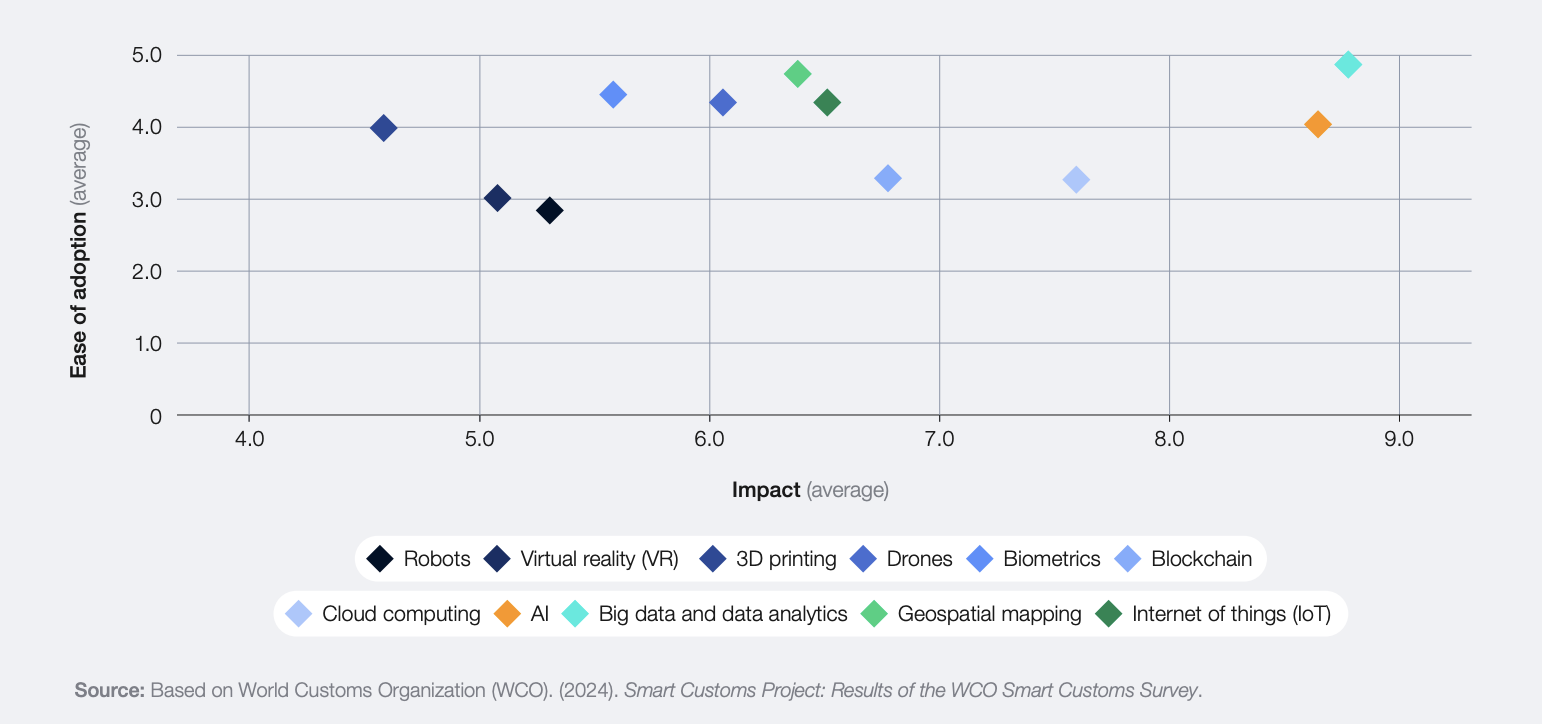
AI adoption in global trade is accelerating, driven by the growing importance of services in cross-border commerce. By enhancing data-driven decision-making and reducing costs, AI technologies are becoming crucial in sectors such as transport, logistics, and trade finance.
AI adoption in trade is accelerating due to:
- Growing treatment of data as a product with improved quality and usability.
- Movement away from proprietary technologies towards open, flexible solutions.
- Increasing “servicification” of trade, where services make up one-third to half of the value in manufacturing exports.
- Concentration of AI innovation in highly tradeable sectors, with over 90% of AI-related patents in just five industries: computer and electronics, machinery, IT services, transport equipment, and electrical equipment.
The WCO Smart Customs Survey indicated that customs officials find AI easier to implement compared to technologies like blockchain and drones, yet its potential impact is significantly higher. This has prompted governments and private-sector companies to invest in AI as part of their strategic trade initiatives.
Efficiency, Sustainability and Inclusivity: The Three Pillars
Efficiency Gains
AI synthesises vast amounts of data, enabling automation, error reduction, and optimisation of processes. It can free up human labour from routine or dangerous tasks, allowing workers to focus on higher-value activities.
Case example – Maqta Technologies Group’s ATLP:
The AI-powered Advanced Trade and Logistics Platform integrates data from over 20 sources, covering 176 million digital transactions, and has:
- Cut documentation requirements by 90%.
- Reduced workers’ time burden by 50–90%.
Sustainability and Scope 3 Emissions Reduction
Scope 3 emissions, which make up 70–95% of an organisation’s environmental footprint, are hard to measure. AI can:
- Improve the accuracy of emissions estimates.
- Provide facility-level data.
- Support compliance with frameworks like the EU’s Carbon Border Adjustment Mechanism.
Case example – AltanaAI: Uses AI and federated learning to measure Scope 3 emissions at scale, improving regulatory compliance and environmental outcomes.
Inclusivity for SMEs
Small and medium-sized enterprises often face regulatory complexity, financing barriers, and operational challenges in cross-border trade. AI tools can:
- Break down language barriers.
- Predict shipping bottlenecks.
- Assist with regulatory compliance.
Case example – DHL MyGTS: Uses AI to analyse trade regulations, estimate costs, and help SMEs plan expansion into new markets.
AI in Trade Finance
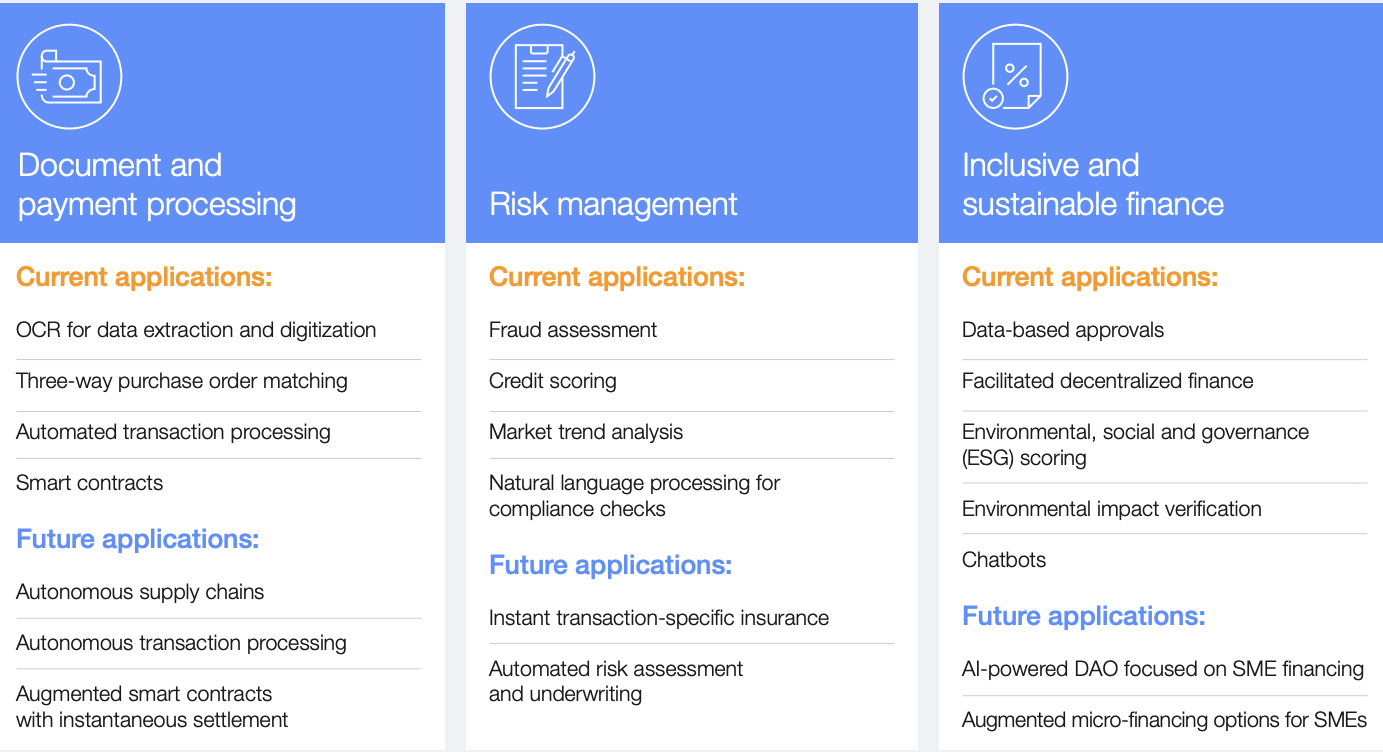
Trade finance is the lifeblood of global commerce, with 80% of trade involving some form of financing—ranging from credit lines to payment guarantees and specialised insurance. Yet, a persistent $2.5 trillion funding shortfall in 2022 limited opportunities, especially for small and medium-sized enterprises (SMEs).
AI is addressing this gap by:
- Reducing inefficiency through the digitisation of traditionally paper-based processes.
- Lowering barriers to entry by providing lenders with data-driven risk assessments for smaller, lesser-known businesses.
- Reducing fraud risk via automated verification of transaction data.
- Increasing transparency across the financing process.
Closing the $2.5 Trillion Trade Finance Gap
AI can drastically shorten credit decisioning times—from weeks to minutes—by extracting, processing and analysing data from documents such as invoices, bills of lading, and customs declarations.
Case example- Jetstream Africa:
In West Africa, Jetstream’s AI-enabled tools have facilitated over $8 million in loans and guarantees for SMEs in Nigeria and Ghana. Using optical character recognition (OCR), Jetstream digitises financial and logistics documents, feeding them into algorithms that cut decisioning time from about one month to less than one minute.
Document Processing and Risk Management
AI systems can perform “three-way purchase order matching” to ensure consistency across orders, invoices and shipping documents, reducing disputes and processing delays.
Example – Twinco Capital: Uses AI to process unstructured shipment paperwork, reducing processing time by 80% and improving accuracy.
Inclusive Financing for SMEs
By improving credit scoring accuracy, AI allows SMEs with limited collateral or credit history to access funding. Future applications include:
- AI-powered decentralised autonomous organisations (DAOs) focused on SME financing.
- Augmented micro-financing options with faster risk assessments.
AI in Customs and Trade Compliance
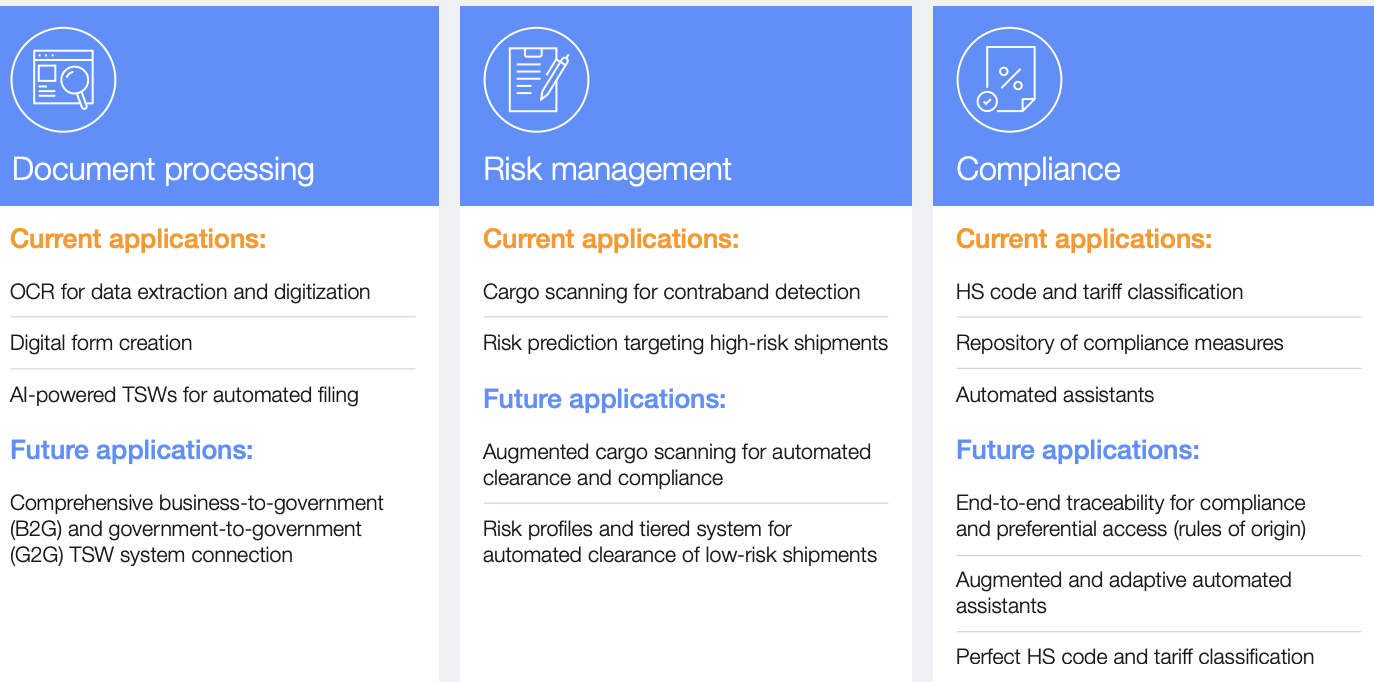
Customs clearance is one of the most paperwork-intensive stages of trade. AI can automate document processing, improve cargo scanning, and simplify compliance with complex regulations.
Document Automation
For example, DSV employs over 2,500 clerks to process more than 500,000 declarations monthly. AI can extract shipment details from unstructured data to populate customs forms, improving speed and accuracy.
Case example – DP World’s CARGOES Customs:
- Uses AI to detect data mismatches in trade documents.
- Employs natural language processing (NLP) for Harmonised System (HS) classification.
- Applies predictive models to identify misclassification or undervaluation risks.
Enhanced Cargo Scanning
AI-powered image recognition tools can detect contraband or counterfeit goods more effectively.
Case example – Project SEEKER:
Developed for Heathrow Airport, it scans up to 250,000 bags daily, with over 70% detection success for certain wildlife contraband.
HS Code Classification and Compliance
With over 10,000 trade restrictions and tariff provisions introduced in the last decade, AI can:
- Automate more than 80% of classifications.
- Improve accuracy from below 50% to 80% or more.
- Audit and update tariff data in real time.
Combating Illicit Trade and Forced Labour
AI assists enforcement of laws such as the US Uyghur Forced Labour Prevention Act by identifying suspicious patterns in supply chains and detecting attempts to conceal unethical practices.
AI in Supply Chains
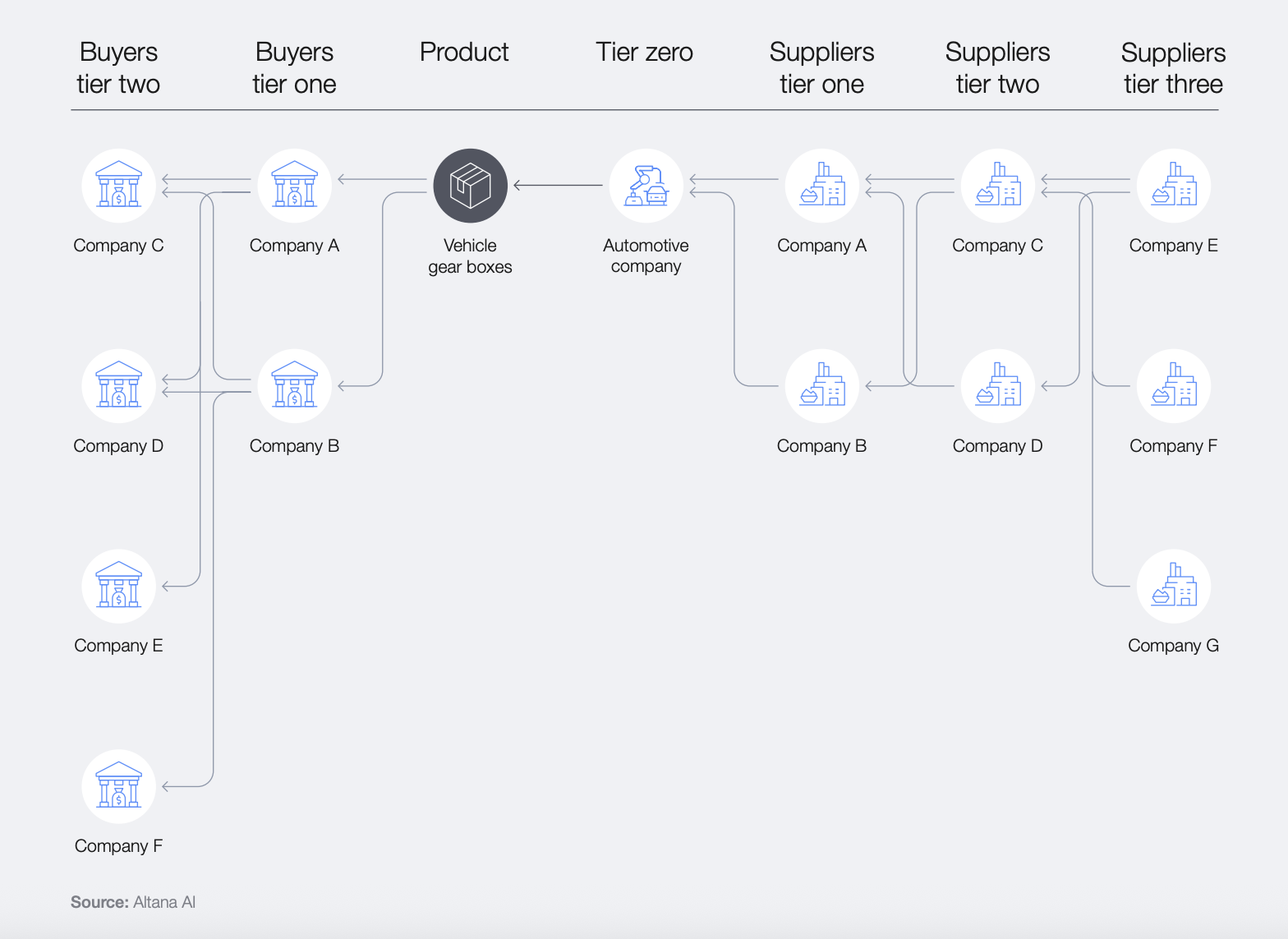
Improving Visibility and Verification- AI enables continuous mapping of multi-tiered supply chains by integrating data from registries, transport documents, and purchase orders, even across multiple languages.
Digital IDs and Authentication- Immutable digital IDs, supported by blockchain or cryptographic signatures, enable trusted authentication of parties in a supply chain, improving security and reducing fraud.
AI for Humanitarian Supply Chains- Projects like the Global Supply Chain Dashboard use AI to anticipate disruptions such as port congestion or natural disasters, improving the delivery of life-saving goods.
Predictive Maintenance and Circular Economy- AI analyses sensor data to predict equipment failures, extend product lifecycles, and improve e-waste recycling processes.
- SK Ecoplant has reduced EV battery dismantling time by 32% and aims for a 30% improvement in recycling efficiency by 2026.
Fraud Detection and Smart Sourcing- AI detects counterfeit goods, valued at $464 billion (2.5% of world trade). Amazon blocked over 700,000 bad actor accounts in 2023, while Alibaba prevented $159 million worth of counterfeit sales in one year.
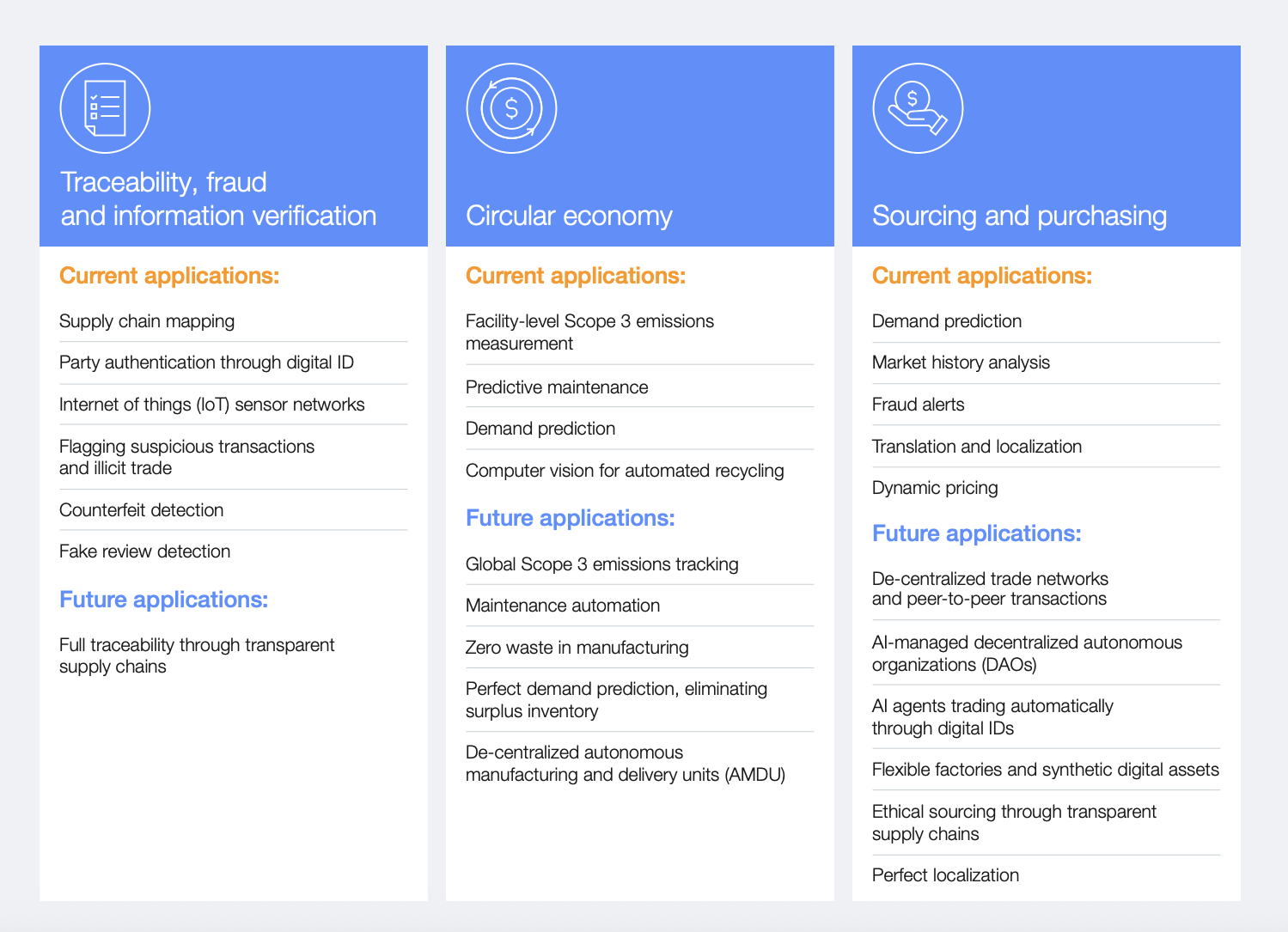
AI in Logistics
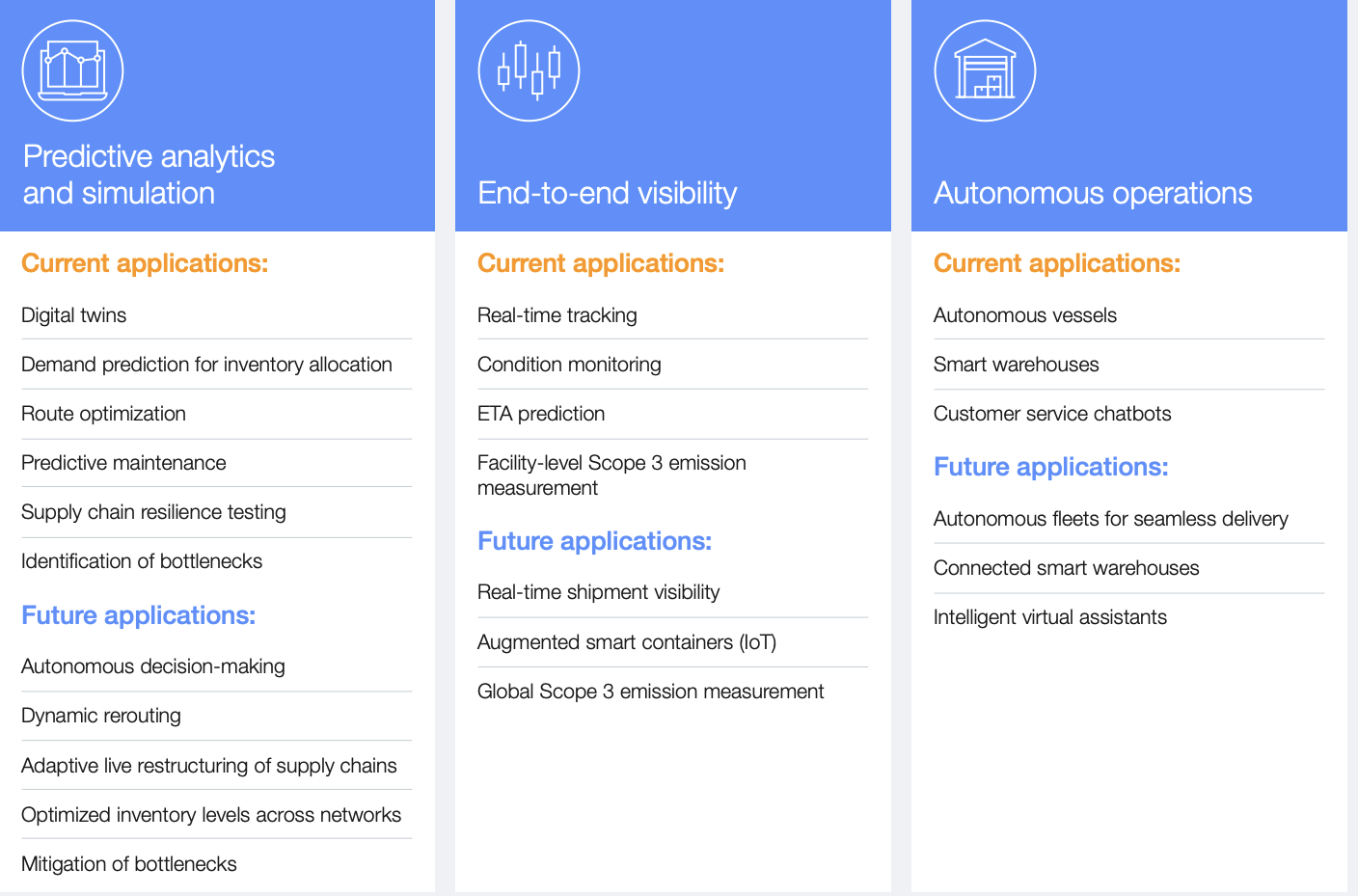
Predictive Analytics and Digital Twins- AI forecasts demand, optimises routes, and anticipates disruptions.
- Maersk uses AI-powered digital twins to simulate port operations, improve training, and reduce risks.
End-to-End Visibility- Real-time tracking with AI and IoT reduces losses and improves compliance.
Automation and Autonomous Operations- From autonomous vessels to AI-powered warehouse robots, automation is increasing accuracy and freeing human workers for strategic tasks.
Costs, complexities and challenges of AI Adoption
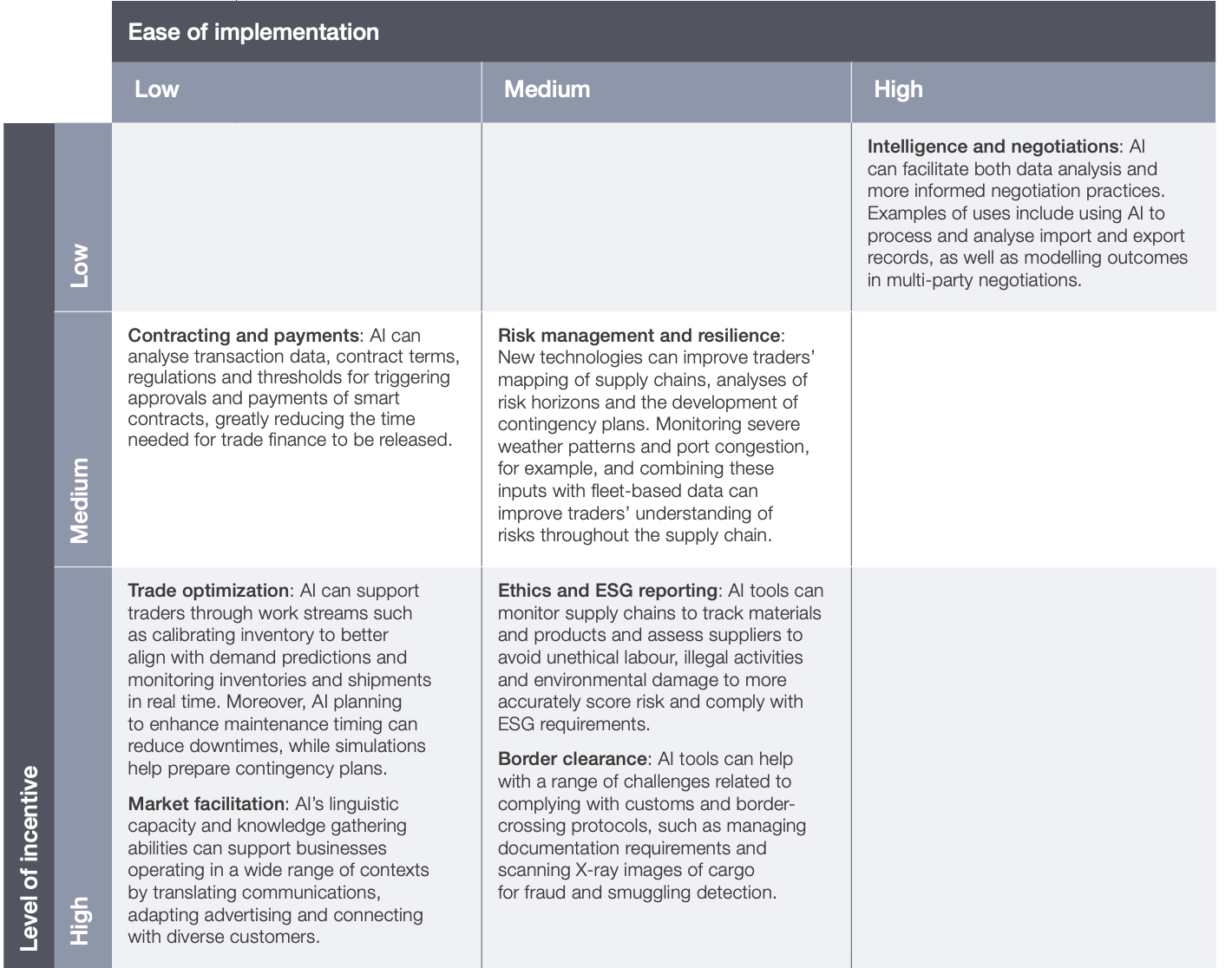
While the benefits are clear, AI adoption involves:
- Upfront investment in hardware, software, and training.
- Operational change management, as workflows shift.
- Regulatory alignment across jurisdictions.
The WEF report identifies four enablers for easier adoption:
- Interoperability – Ensuring systems across countries and industries can work together.
- Trust – Verifiable data inputs are essential for accurate AI outputs.
- Public-Private Partnerships (PPPs) – Aligning incentives between governments and businesses.
- Workforce Development – Reskilling employees to work alongside AI.
Interoperability Challenges
Many organisations still operate on legacy systems. Developing common standards for communication protocols, cybersecurity benchmarks, and legal definitions is crucial for integration.
Building Trust and Data Accuracy
Initiatives like the verifiable Legal Entity Identifier (vLEI) provide cryptographic identities for each party in a trade transaction, reducing fraud and errors.
Emerging tools such as zero-knowledge proofs (ZKP) allow compliance verification without exposing sensitive data—balancing transparency with privacy.
Public-Private Partnerships (PPPs)
Effective AI deployment in trade requires the combined expertise of:
- Governments (regulatory frameworks, funding, ethics).
- Businesses (technical innovation, operational execution).
- Academia (research, training).
- Civil society (oversight, public trust).
Example- TradeTech Regulatory Sandbox:
A UAE-based initiative allowing start-ups and regulators to test AI and blockchain trade finance solutions in a controlled environment.
Regulatory Sandboxes and Global Coordination
The sandbox model enables experimentation while informing international best practices. It is adaptable beyond trade finance into customs, logistics and supply chain resilience.
AI convergence vs AI divergence: Future scenarios
The Case for Convergence
AI convergence could boost cumulative trade growth by 13.6 percentage points by 2040, with benefits spread evenly across economies.
Avoiding Fragmentation
Without coordination, AI divergence may create “trade islands”, concentrating benefits in early-adopting economies—similar to how containerisation initially favoured North-North trade.
Human-AI and Human-Human Collaboration
For optimal outcomes, AI should complement—not replace—human decision-making.
- Human-AI collaboration: AI processes and analyses large data sets; humans provide strategic and ethical judgment.
- Human-human collaboration: International cooperation on regulations, interoperability and ethical standards.
The transformative power of AI in global trade is clear. By streamlining operations, cutting costs, reducing environmental impact, and opening new markets, AI has the potential to redefine who participates in trade and how it is carried out. But to fully realise these benefits, global cooperation is essential.
This includes investing in digital infrastructure and workforce skills, creating shared technical and regulatory standards, and encouraging public-private partnerships to close capability gaps. Initiatives like the TradeTech Global Initiative can help scale successful pilots around the world. Ultimately, whether AI becomes an inclusive force for good or a tool that widens existing divides will depend on how the world chooses to harness it.
As the WEF report emphasises, success will be measured not by AI’s technical sophistication alone, but by its role in building a more sustainable, inclusive, and efficient global trade system.

Shikha Negi is a Content Writer at ztudium with expertise in writing and proofreading content. Having created more than 500 articles encompassing a diverse range of educational topics, from breaking news to in-depth analysis and long-form content, Shikha has a deep understanding of emerging trends in business, technology (including AI, blockchain, and the metaverse), and societal shifts, As the author at Sarvgyan News, Shikha has demonstrated expertise in crafting engaging and informative content tailored for various audiences, including students, educators, and professionals.
